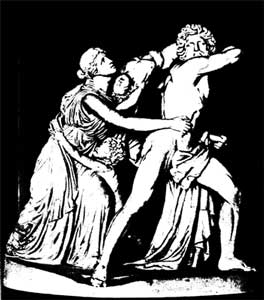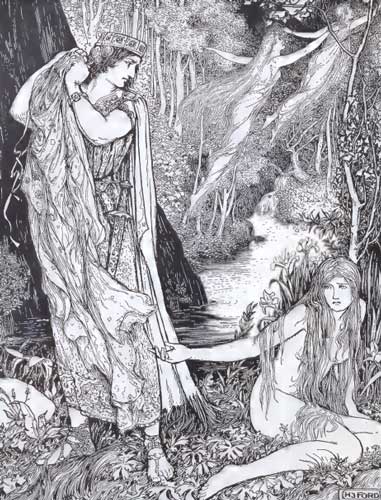.

Furry of Athamas, J. Flaxman, 1790/2
The king of Orchomenus in Greek mythology, Athamas ( Ἀθάμας , Αθάμας) ("rich harvest") was married first to the goddess Nephele with whom he had the twins Phrixus and Helle. He later divorced Nephele and married Ino, daughter of Cadmus. With Ino, he had two children: Learches and Melicertes. Athamas also had a brother, Salmoneus, who was the father of Tyro.
Phrixus and Helle, were hated by their stepmother, Ino. Ino hatched a devious plot to get rid of the twins, roasting all the towns crop seeds so they would not grow. The local farmers, frightened of famine, asked a nearby oracle for assistance. Ino bribed the men sent to the oracle to lie and tell the others that the oracle required the sacrifice of Phrixus. Athamus reluctantly agreed. Before he was killed though, Phrixus and Helle were rescued by a flying golden ram sent by Nephele, their natural mother. Helle fell off the ram into the Hellespont (which was named after her) and died, but Phrixus survived all the way to Colchis, where King Aeetes took him in and treated him kindly, giving Phrixus his daughter, Medea, in marriage. In gratitude, Phrixus gave the king the golden fleece of the ram, which Aeetes hung in a tree in his kingdom.
Later, Ino raised Dionysus, her nephew, son of her sister Semele, causing Hera's intense jealousy. In vengeance, Hera struck Athamas with insanity. Athamas went mad, and slew one of his sons, Learchus; Ino, to escape the pursuit of her frenzied husband, threw herself into the sea with her son Melicertes. Both were afterwards worshipped as marine divinities, Ino as Leucothea, Melicertes as Palaemon.

Athamas and Nephele
Athamas, with the guilt of his son's murder upon him, was obliged to flee from Boeotia. He was ordered by the oracle to settle in a place where he should receive hospitality from wild beasts. This he found at Phthiotis in Thessaly, where he surprised some wolves eating sheep; on his approach they fled, leaving him the bones. Athamas, regarding this as the fulfilment of the oracle, settled there and married a third wife, Themisto (son: Schoeneus). The spot was afterwards called the Athamanian plain.
When Athamas returned to his second wife, Ino, Themisto sought revenge by dressing her children in white clothing and Ino's in black. Ino switched their clothes without Themisto knowing and she killed her own children.
Works of Art
Athamas by Aristonidas
Ovid , Metamorphoses, IV, 416
See also : Greek Mythology. Paintings, Drawings
| Ancient Greece
Science, Technology , Medicine , Warfare, , Biographies , Life , Cities/Places/Maps , Arts , Literature , Philosophy ,Olympics, Mythology , History , Images Medieval Greece / Byzantine Empire Science, Technology, Arts, , Warfare , Literature, Biographies, Icons, History Modern Greece Cities, Islands, Regions, Fauna/Flora ,Biographies , History , Warfare, Science/Technology, Literature, Music , Arts , Film/Actors , Sport , Fashion --- |
Retrieved from "http://en.wikipedia.org"
All text is available under the terms of the GNU Free Documentation License

